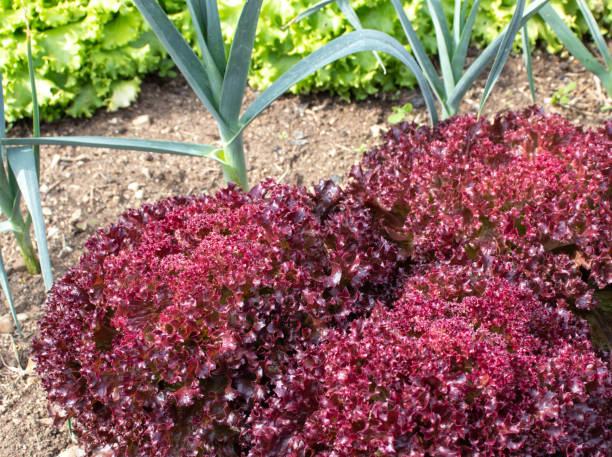Introduction:
Welcome to our comprehensive guide on companion planting for different vegetables! Whether you’re an experienced gardener or just starting out, understanding the principles of companion planting can greatly enhance the health and productivity of your vegetable garden. In this article, we’ll explore the benefits of companion planting, provide you with practical tips, and suggest compatible plant combinations for various vegetables. So, let’s dig in!

Section 1: What is Companion Planting?
Companion planting is a gardening technique that involves strategically planting different plants together to maximize their growth and deter pests. By selecting compatible plant combinations, you can create a harmonious ecosystem where each plant supports and benefits from the others.
Section 2: The Benefits of Companion Planting
Companion planting offers numerous advantages for your vegetable garden. Firstly, it helps repel pests naturally, reducing the need for harmful pesticides. Secondly, certain plants act as natural insect repellents, attracting beneficial insects that prey on garden pests. Thirdly, companion plants can enhance soil fertility by fixing nitrogen or providing shade and moisture regulation. Lastly, some combinations improve pollination, leading to higher yields and better quality produce.
Section 3: Practical Tips for Companion Planting
To successfully implement companion planting in your garden, keep the following tips in mind:
1. Choose your vegetable combinations wisely: Research which plants grow well together and which ones should be kept apart. Some combinations thrive when planted together, while others compete for resources.
2. Consider plant height and spreading habits: Arrange your plants based on their height to prevent overshadowing. Tall plants could shade shorter ones and hinder their growth.
3. Rotate your crops: To avoid depleting the soil of essential nutrients and to minimize disease and pest problems, practice crop rotation each season.
Section 4: Companion Planting Suggestions for Different Vegetables
Here are some tried-and-tested companion planting combinations for popular vegetables:
1. Tomatoes: Plant basil, marigolds, or garlic nearby to repel pests and improve tomato flavor.
2. Carrots: Pair with onions, chives, or leeks to deter carrot fly and promote healthy growth.
3. Cucumbers: Plant radishes or corn alongside to provide shade and deter cucumber beetles.
4. Beans: Grow beans alongside corn or other nitrogen-fixing plants to enhance soil fertility.
Section 5: Conclusion and Call to Action
Companion planting is a valuable technique that can transform your vegetable garden into a thriving ecosystem. By carefully selecting plant combinations and implementing the tips we’ve shared, you’ll enjoy healthier plants, increased yields, and reduced pest problems. Experiment with different combinations and observe the results for yourself!
Start implementing companion planting today and reap the rewards of a well-balanced and productive garden. Happy gardening!
Remember, if you have any questions or need further guidance, our team of gardening experts is here to assist you
So, get your hands dirty and start companion planting for a bountiful harvest! Section 6: Additional Resources for Further Learning
To expand your knowledge on companion planting and improve your gardening skills, here are some additional resources you can explore:
1. Books: Check out “Carrots Love Tomatoes” by Louise Riotte and “Great Garden Companions” by Sally Jean Cunningham. These books provide in-depth information on companion planting and offer a wealth of plant combinations for different vegetables.
2. Online Gardening Communities: Join online gardening forums and communities where you can connect with experienced gardeners and exchange valuable insights on companion planting.
3. Garden Planning Tools: Utilize online garden planning tools that provide recommendations for companion planting based on the specific vegetables you want to grow. These tools can save you time and help you make informed decisions about plant placement in your garden.
4. Local Gardening Workshops: Attend gardening workshops and seminars in your area. Many gardening centers and botanical gardens organize educational events where you can learn from experts and gain hands-on experience in companion planting techniques.
Conclusion:
Companion planting is a practical and sustainable approach to gardening that can significantly improve the health and productivity of your vegetable garden. By implementing the tips and suggestions provided in this comprehensive guide, you’ll be well-equipped to create thriving plant communities and enjoy the benefits that companion planting offers.
Remember, successful companion planting requires experimentation and observation. Each garden is unique, so don’t be afraid to try different combinations and adjust your approach based on your specific conditions and experiences.
So, roll up your sleeves, gather your seeds, and embark on the journey of companion planting. Your vegetable garden will flourish, and you’ll be rewarded with delicious, healthy produce for your table. Happy planting!
Section 7: Companion Planting Essentials
At e commerce portals, offers a wide range of companion planting essentials to help you get started on your gardening journey. Here are some Companion Planting products you may find useful:
1. Organic Pest Repellents: Browse e commerce portals selection of organic pest repellents such as neem oil, diatomaceous earth, and insecticidal soaps. These natural solutions will help protect your plants from common pests without harming beneficial insects.
2. Seed Collections: Explore e commerce portals specially curated seed collections that include companion plants known for their beneficial properties. These collections take the guesswork out of choosing compatible plant combinations and ensure a successful companion planting experience.
3. Raised Garden Beds: Consider investing in e commerce portals durable and convenient raised garden beds. These beds provide excellent drainage, prevent soil compaction, and make it easier to arrange your companion plants in an organized manner.
4. Gardening Tools: Find a wide selection of gardening tools, including hand trowels, pruners, and watering cans. Having the right tools on hand will make your companion planting endeavours more efficient and enjoyable.
Visit e commerce website to explore our full range of companion planting products and gardening resources. E commerce website offer convenient online ordering and fast shipping to help you get started on your companion planting journey as soon as possible.
Section 8: Call to Action
Now that you have a comprehensive understanding of companion planting and its benefits, it’s time to put your knowledge into action. Plan your garden layout, select the compatible plant combinations that suit your vegetable preferences, and start sowing your seeds.
Remember, companion planting is a journey of discovery and learning. Don’t be discouraged if you come across challenges along the way. With patience, observation, and a bit of experimentation, you’ll unlock the secrets of successful companion planting and enjoy the rewards it brings to your vegetable garden.
So, let’s get started! Transform your garden into a thriving ecosystem of beneficial plant communities through the art of companion planting. Your vegetables will thank you with abundant harvests and healthy growth. Happy gardening!
Disclaimer: The information provided in this blog post is for informational purposes only. Always consult local gardening experts or extension services for region-specific recommendations and advice.

Frequently Asked Questions About Companion Planting for Different Vegetables
1. What is companion planting?
Companion planting is a gardening technique where different plants are grown together to benefit each other in various ways, such as attracting beneficial insects, repelling pests, or improving soil fertility.
2. Why should I consider companion planting?
Companion planting offers several advantages, such as natural pest control, improved pollination, maximized space utilization, enhanced crop health, and increased yields. It’s an eco-friendly and sustainable approach to gardening.
3. Which vegetables can benefit from companion planting?
Numerous vegetables can benefit from companion planting, including tomatoes, peppers, cucumbers, lettuce, beans, corn, carrots, and many others. Each vegetable has specific companion plants that can help them thrive.
4. What are some popular companion plants for vegetables?
Some common companion plants for vegetables include marigolds, basil, nasturtiums, chives, onions, garlic, dill, and mint. These plants can repel pests, attract beneficial insects, or provide shade and support.
5. How do I choose the right companion plants for my vegetables?
Consider the specific needs of your vegetables and the benefits you want to achieve. Some plants repel specific pests, while others attract pollinators or improve soil health. Research companion planting charts or guides to find suitable combinations.
6. Can companion planting help deter pests?
Yes, companion planting can be an effective natural pest control method. For example, planting marigolds alongside tomatoes can repel aphids, while planting onions or garlic near carrots can deter carrot flies.
7. Are there any plants that should not be grown together?
Yes, some plants are not good companions and may interfere with each other’s growth. For instance, potatoes and tomatoes should be kept separate to prevent the spread of diseases.
8. Are there any plants that are good companions for most vegetables?
Certain plants are considered beneficial companions for many vegetables. These include herbs like thyme, rosemary, and sage, as well as flowers such as marigolds and calendula.
9. How close should I plant companion plants to my vegetables?
The distance between companion plants and vegetables depends on their specific requirements. Some may need to be planted directly alongside the vegetable, while others can be planted nearby.
10. Can companion planting improve soil fertility?
Yes, certain plants, known as nitrogen-fixing plants, can enhance soil fertility by converting atmospheric nitrogen into a usable form. Examples include legumes like peas and beans.
11. Can companion planting help with weed control?
Yes, companion planting can help suppress weeds by creating dense plantings that shade the soil and prevent weed growth. For example, growing tall plants like corn alongside sprawling plants like squash can effectively smother weeds.
12. Is it necessary to rotate companion plants each year?
Crop rotation is generally recommended to prevent the buildup of pests or diseases in the soil. However, companion plants don’t always need to be rotated if they are providing beneficial effects without causing negative impacts.
13. Can I practice companion planting in containers or raised beds?
Absolutely! Companion planting can be applied in various gardening methods, including containers and raised beds. Just ensure that the companion plants you choose are suitable for the size and conditions of the containers or beds.
14. Are there any resources available for further information on companion planting?
Yes, there are numerous books, websites, and gardening forums dedicated to companion planting. Some recommended resources include “Carrots Love Tomatoes & Roses Love Garlic” by Louise Riotte, online gardening blogs, and forums where experienced gardeners share their insights.
15. How do I maintain a successful companion planting garden?
To maintain a successful companion planting garden, regularly monitor your plants for signs of pests or diseases. Take preventive measures, such as providing adequate water and nutrients, practicing good hygiene, and removing any diseased or infested plants promptly.
16. Can companion planting be used in organic gardening?
Yes, companion planting aligns well with organic gardening principles. It reduces the need for synthetic pesticides and promotes a balanced ecosystem within your garden.
17. Can I mix flowers and vegetables in companion planting?
Absolutely! Mixing flowers and vegetables in companion planting not only adds beauty to your garden but also attracts beneficial insects like bees and butterflies. Flowers like marigolds, zinnias, and sunflowers can be great companions for vegetables.
18. Can companion planting be applied in a small-scale garden?
Yes, companion planting is suitable for small-scale gardens as well. It can be especially beneficial in maximizing space utilization and promoting healthy plant growth in limited areas.
19. Are there any disadvantages to companion planting?
While companion planting has numerous benefits, it’s important to consider the specific needs and preferences of each plant. Some plants may not thrive well together due to competition for resources or incompatible growing conditions.
20. Can I experiment with my own companion planting combinations?
Absolutely! Gardening is a creative endeavour, and you can certainly experiment with your own companion planting combinations. Keep track of your observations and adjust your approach based on the results.
21. Where can I find a comprehensive guide on companion planting for different vegetables?
For a comprehensive guide on companion planting for different vegetables, you can visit gardening websites, check out gardening books from your local library, or search for downloadable e-books on the topic. Additionally, you can find informative articles and guides on reputable gardening blogs and websites specializing in vegetable gardening.
Remember, companion planting is a rewarding practice that takes time and experimentation to master. Enjoy the process of discovering which plants work best together and reap the benefits of a thriving, harmonious garden!
Comprehensive Guide on Companion Planting for Different Vegetables
If you’re looking for a comprehensive guide on companion planting for different vegetables, you’re in the right place! This guide will provide you with valuable insights and tips to help you create a successful companion planting garden.
1. Understand the Needs of Your Vegetables:
Before diving into companion planting, it’s important to understand the specific needs of the vegetables you plan to grow. Consider following factors such as soil conditions, sunlight requirements, and watering needs. This knowledge will help you select suitable companion plants that can thrive alongside your vegetables.
2. Plan Your Garden Layout:
Take time to plan your garden layout before planting. Consider the growth habits and sizes of your vegetables and companion plants. Tall plants can provide shade for shorter ones, while sprawling plants can act as ground cover to suppress weeds. Make sure to provide enough space for each plant to grow and access adequate sunlight.
3. Choose Compatible Companion Plants:
Select companion plants that have beneficial interactions with your vegetables. For example, planting aromatic herbs like basil or dill near tomatoes can help repel pests. Similarly, growing flowers like marigolds or nasturtiums alongside cucumbers can attract pollinators and deter pests. Research specific companion planting charts or guides to find suitable combinations for your vegetables.
Learn More: The Cauliflower Blooms of Bihar: A Pathway to Prosperity
4. Avoid Incompatible Combinations:
Just like some plants thrive together, others may hinder each other’s growth. For instance, avoid planting onions or other alliums near beans or peas, as they can stunt their growth. Research potential incompatibilities to ensure you create a harmonious garden.
5. Rotate Crops:
To prevent the buildup of pests and maintain soil health and diseases, practice crop rotation. Rotate your vegetables and companion plants each year, ensuring they are not planted in the same location consecutively. This helps maintain a balanced ecosystem and reduces the risk of plant-specific pests or diseases.
6. Implement Succession Planting:
To maximize your harvest and extend the growing season, consider succession planting. This involves planting new crops as soon as the previous ones are harvested. Companion planting can be incorporated into succession planting by ensuring the new crops are compatible with the existing ones.
यह भी पढ़े: फूलगोभी की वैज्ञानिक खेती सम्पूर्ण जानकारी !
7. Monitor and Maintain:
Regularly monitor your garden for any signs of pests, diseases, or nutrient deficiencies. Take proactive procedures to address any issues promptly. This may include using organic pest control methods, providing adequate water and nutrients, and removing any diseased plants to prevent the spread of diseases.
8. Learn from Experience:
Companion planting is a learning process, and each garden is unique. Keep a journal to record your observations and outcomes. Take note of successful combinations and any challenges you encounter. Over time, you’ll gain valuable insights into what works best for your specific garden and growing conditions.
9. Share and Learn from Others:
Join gardening communities, online forums, or local gardening clubs to connect with fellow gardeners. Sharing experiences and knowledge can provide you with additional tips and ideas for companion planting. You can learn from the experiences of others and contribute your own insights to the gardening community.
Remember, companion planting is both an art and a science. It requires experimentation, observation, and adaptation. By following these guidelines and being open to learning, you’ll be well on your way to creating a thriving garden that benefits from the power of companion planting.
